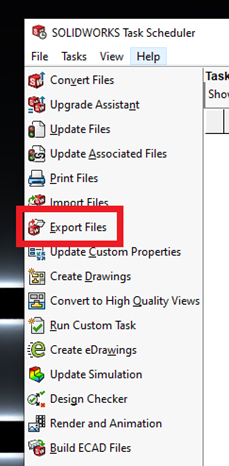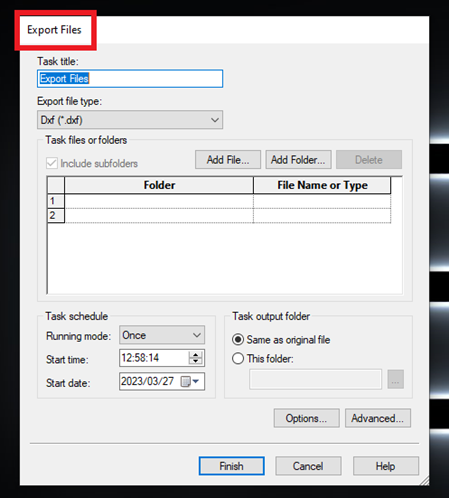Using SOLIDWORKS Task Scheduler to automate file exporting.
To streamline the communication of designs, it is a common practice in SOLIDWORKS to export approved drawings as PDF files. However, this process can become time-consuming when dealing with multiple drawings. Luckily, the SOLIDWORKS Task Scheduler is available to automate various tasks, including the exporting of files to different formats.
SOLIDWORKS Task Scheduler capabilities:
One of the benefits of this tool is that it can be used with any SOLIDWORKS package to convert documents to the latest version of the software. However, to schedule tasks beyond document conversion, a SOLIDWORKS Professional or Premium package is required.
It is also important to note that SOLIDWORKS PDM Professional has its own built-in automated tasks for exporting files to various formats. SOLIDWORKS Task Scheduler is independent of PDM, therefore non-PDM users can benefit from using it.
As seen below, SOLIDWORKS Task Scheduler is capable of several functions:
| Task | Description |
| Convert Files | Converts SOLIDWORKS files to the latest release file type. |
| Upgrade Assistant | Tests the upgrade of parts, assemblies, and drawings. |
| Update Files | Rebuilds specified files. |
| Update Associate Files | Rebuilds the file, and any associated files located in the folder. |
| Print Files | Automate printing files with default/selected printer options. |
| Import Files | Imports STEP/IGES files and converts them to SOLIDWORKS documents. |
| Export Files | Export SOLIDWORKS documents to DXF, DWG, IGES, STEP AP2023, and STEP AP214. |
| Update Custom Properties | Add/modify custom properties within a specified file. |
| Create Drawings | Automate creating drawings based off of a custom drawing template. |
| Convert to High Quality Views | Converts drawing views from draft quality to high quality. |
| Run Custom Task | Runs any application using macros or command-line arguments. |
| Create eDrawings | Creates eDrawings. |
| Update Simulation | Updates the SOLIDWORKS Simulation analysis parameters in specific files. |
| Design Checker | Checks SOLIDWORKS documents against existing standard files. |
| Render and Animation | Manages rendering and animations tasks. |
| Build ECAD Files | Builds multiple ECAD files (used by CircuitWorks) as SOLIDWORKS solid models. |
This article will specifically cover the Export Files Task. It is worth noting that all tasks within the SOLIDWORKS Task Scheduler function similarly, so understanding one task will assist in understanding the others.
To access the SOLIDWORKS Task Scheduler, open the standalone application from the Windows Start menu. To do so, navigate to the Windows Start icon, and search “SOLIDWORKS Task Scheduler”. From here, select the “Export files” task from the sidebar, which will open the Export Files dialog box.


Steps:
1. Enter a task title or leave the default.
2. Select the desired file type for export from the available formats.
3. Add file / folder you wish to convert.
4. Under Task Schedule, select the desired running mode, start time and start date.
5. Under Task output folder, select “Same as original file” to save the exported file in the same location as the original files or select “This folder” to specify a different location for the exported files.
6. Additional parameters can be edited using the “Options” and “Advanced” tabs.
Once you have set up the task and clicked “Finish”, the task will appear in the Tasks panel with its title, scheduled time, date, and status. By default, the status of the task is “Scheduled”.

IMPORTANT:
The computer must be on at the scheduled start time for the task to run. The SOLIDWORKS Task Scheduler window does not need to be open for the task to run. If the computer is off at the scheduled start time, the task runs when the computer is turned on. Once the task completes, the status changes to “Completed”.
Date: 03/04/2023
